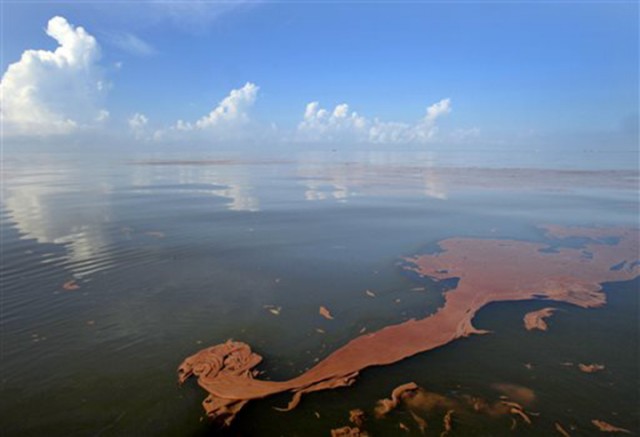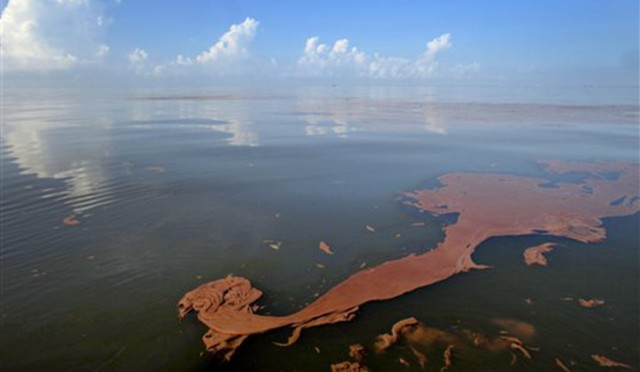
Associated Press
Michael Kunzelman
and Jeff Donn
Associated Press
GULF OF MEXICO — A blanket of fog lifts, exposing a band of rainbow sheen that stretches for miles off the coast of Louisiana. From the vantage point of an airplane, it’s easy to see gas bubbles in the slick that mark the spot where an oil platform toppled during a 2004 hurricane, triggering what might be the longest-running commercial oil spill ever to pollute the Gulf of Mexico.
Yet more than a decade after crude started leaking at the site formerly operated by Taylor Energy Company, few people even know of its existence. The company has downplayed the leak’s extent and environmental impact, likening it to scores of minor spills and natural seeps the Gulf routinely absorbs.
An Associated Press investigation has revealed evidence that the spill is far worse than what Taylor — or the government — have publicly reported during their secretive, and costly, effort to halt the leak. Presented with AP’s findings, that the sheen recently averaged about 91 gallons of oil per day across eight square miles, the Coast Guard provided a new leak estimate that is about 20 times greater than one recently touted by the company.
Outside experts say the spill could be even worse — possibly one of the largest ever in the Gulf.
Taylor’s oil was befouling the Gulf for years in obscurity before BP’s massive spill in mile-deep water outraged the nation in 2010. Even industry experts haven’t heard of Taylor’s slow-motion spill, which has been leaking like a steady trickle from a faucet, compared to the fire hose that was BP’s gusher.
Taylor, a company renowned in Louisiana for the philanthropy of its deceased founder, has kept documents secret that would shed light on what it has done to stop the leak and eliminate the persistent sheen.
The Coast Guard said in 2008 the leak posed a “significant threat” to the environment, though there is no evidence oil from the site has reached shore. Ian MacDonald, a Florida State University biological oceanography professor and expert witness in a lawsuit against Taylor, said the sheen “presents a substantial threat to the environment” and is capable of harming birds, fish and other marine life.
Using satellite images and pollution reports, the watchdog group SkyTruth estimates between 300,000 and 1.4 million gallons of oil has spilled from the site since 2004, with an annual average daily leak rate between 37 and 900 gallons.
If SkyTruth’s high-end estimate of 1.4 million gallons is accurate, Taylor’s spill would be about 1 percent the size of BP’s, which a judge ruled amounted to 134 million gallons. That would still make the Taylor spill the 8th largest in the Gulf since 1970, according to a list compiled by the National Oceanic and Atmospheric Administration.
“The Taylor leak is just a great example of what I call a dirty little secret in plain sight,” said SkyTruth President John Amos.
Taylor has spent tens of millions of dollars to contain and stop its leak, but it says nothing can be done to completely halt the chronic slicks.
The New Orleans based company presented federal regulators last year with a proposed “final resolution” at the site, but the details remain under wraps. For years, the government has allowed the company to shield other spill-related information from public scrutiny — all in the name of protecting trade secrets.
Industry experts and environmental advocates are baffled by Taylor’s inability to stop the leak and its demands for confidentiality.
“It’s not normal to have a spill like this,” said Ken Arnold, an industry consultant and former engineering manager for Shell Oil Company. “The whole thing surprises me. Normally, we fix things much more quickly than this.”
LEARNING CURVE
Hurricane Ivan whipped into the Gulf of Mexico in 2004, churning up waves that triggered an underwater mudslide and toppled Taylor’s platform. The platform stood roughly 10 miles off Louisiana’s coast in approximately 475 feet of water. The mudslide buried the cluster of 28 wells under mounds of sediment. Taylor tried to remove the unstable sediment covering the damaged wells, but determined it was too dangerous for divers.
Without access to the buried wells, traditional “plug and abandon” efforts wouldn’t work.
In 2005, hurricanes Katrina and Rita disrupted the company’s response efforts for several months. In 2007, slick sightings became more frequent near the wreckage. In 2008, the Coast Guard, concerned about the environmental threat of the leak, ordered additional work, including daily monitoring flights over the site.
Just as BP had to improvise a method for capping its well in mile-deep water, Taylor says it formulated an “unprecedented plan” for containing the leak and sealing its buried wells.
Only the broad outlines of the company’s efforts are publicly known. A contractor designed a device to capture and dispose of oil and gas flowing from the seabed where its wells are buried.
Another contractor drilled new wells to intercept and plug nine wells deemed capable of leaking oil.
A year ago, federal officials convened a workshop on the leak. Months later, the company presented regulators its proposal for a final resolution at the site. That plan remains confidential, but Taylor Energy President William Pecue has said experts and government officials agree that the “best course of action … is to not take any affirmative action” due to the possible risks of additional drilling.
Taylor had to share confidential records with the Waterkeeper Alliance, a New York City-based environmental group that sued the company in 2012 over its secrecy. But the company has aggressively worked to keep them from the public, stamping thousands of pages of documents as confidential and heavily redacting its president’s deposition.
A report related to the March 2014 workshop is under seal, with the company arguing in a court filing that releasing it would undermine the government’s decision-making process. And a court order prohibits the Waterkeeper Alliance from disseminating any of the confidential records.
During his deposition for the lawsuit, Pecue said the company developed innovations of “huge value” to another company in a similar situation.
“Much of what we spent was because there was no pre-existing way to address this type of event in the history of our industry,” he said.
Long before Taylor’s leak, the industry learned of the risks of drilling in the Gulf’s mudslide-prone areas. In 1969, Hurricane Camille caused a mudslide that destroyed a platform and damaged another.
Taylor’s platform had been installed in 1984 by Sohio Petroleum, which started drilling wells before the company was acquired by BP. Taylor purchased the platform from BP in 1994 and drilled additional wells.
Pecue, the company’s last remaining full-time employee, said Taylor didn’t do anything to assess the risk of mudslides at its platform besides verifying that the previous leaseholder’s permits and designs met regulatory requirements.
Soon after Taylor’s platform toppled, a company contractor hired Louisiana State University professor Harry Roberts to perform a geological analysis of the site. Roberts said it had appeared to have been “reasonably stable” before Ivan struck.
“But it turned out not to be,” he added. “It is a learning curve. Maybe this is a point on the learning curve that other companies can learn from.”
A PERFECT LAB
Amos isn’t the only skeptic. MacDonald, the Florida State University professor who is an expert witness for the Waterkeeper Alliance, leads a team of researchers tracking the sheen with satellite imagery, aerial photography and samples from the water.
MacDonald didn’t respond to an interview request. But in a court filing he said he suspects the company has used outdated mathematical formulas. His “conservative” estimate is that Taylor’s reports lowball the amount of oil leaking by, on average, “a factor of 100 or more.”
Gaps and complex variables in the data make it impossible to pinpoint how much oil has actually spilled. Doug Helton, operations coordinator for NOAA’s Emergency Response Division, said estimating the volume of slicks is hindered by the difficulty of determining the thickness of the oil.
“It’s hard to do that from satellites. It’s hard to do that from flying by in an aircraft,” Helton said.
Oil slicks from both natural and man-made sources are common in the Gulf of Mexico. Every year, millions of gallons of crude seep naturally from cracks in the seabed. Massive spills like BP’s are rare, but offshore accidents often pollute the Gulf with smaller quantities of oil.
The Interior Department also says small leaks have been detected from abandoned wells that may have been unsuccessfully sealed by the companies that drilled them. A 2010 AP investigation revealed federal regulators weren’t routinely inspecting more than 27,000 abandoned wells in the Gulf.



